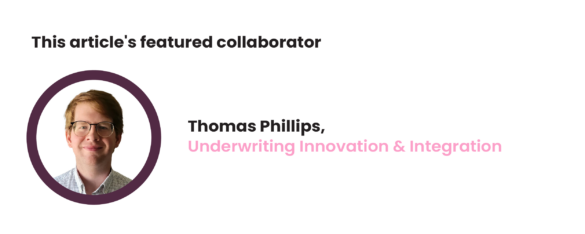Finding the next generation of insurance workers and clients

The insurance industry has a problem. Two actually. First, too few younger professionals are looking at the field as a rewarding career choice and last, those same younger professionals are less likely to buy life insurance. It’s not that they aren’t marketing to attract both, they are but their messaging is tired, outdated, and frankly geared to an older audience.
Will this issue be the industry’s Waterloo? Possibly, especially if they don’t get their act together.
When you ask 8-year-olds what they want to be when they grow up, most choose careers like fireman, doctor, veterinarian, or professional skateboarder. I’m pretty sure no kid has ever answered (truthfully anyway), “I’d like to work in life insurance and be an underwriter!” That may seem funny, but without more younger people entering the industry or taking part as applicants, the industry might just be hurtling toward oblivion.
The reality is this: workers are aging out and it seems the industry as a whole is whistling past the graveyard and unable to recognize they need to step up if they want a younger generation to join their ranks. And that is a serious problem. For everyone.
Insurance is bo-ring!
Because there are so many different types of insurance and no two companies are identical, so for the sake of clarity, we’ll just discuss the life insurance sector today. Let’s begin by discussing workers and we’ll tackle attracting a new generation of applicants in just a minute.
Now, there are some large insurance companies who manage to achieve making car or home insurance seem kind of cool through advertising, but when you get to typical life insurers, all bets are off. Their advertising is marketed to seniors by offering affordable Final Expense or Simplified Issue plans on channels airing Columbo and Little House reruns. It may be lucrative, but it sure isn’t doing much to help them attract millennials to join their company or industry.
To get a better perspective on the topic, we spoke with Thomas Phillips, Underwriting Innovation & Integration in the US expert, and himself a millennial, to learn more.
We asked him about the current state of play and he had a lot to say, starting with this:
I think this is where we are right now. Too many insurance organizations say they want younger grads to join their outdated organizations yet they don’t act to make their firm attractive to us. Some insurance firms are calling editable PDFs a digital customer journey, and it just isn’t. This is very unappealing to younger talent.”
And that’s the crux of the problem. There are just too many products, companies, technologies, and business processes that are simply too old-fashioned, staid, or dull to attract a new generation of college grads or anyone under 40 to want to join it.
To find out more about what thinktum sees on the horizon, read thinktum and the future of insurance.
The world has changed, and insurance needs to catch up.
When the working world was flipped upside-down in early 2020, the first thing to happen was employees all began to work from home. Insurance was no exception. The trouble is many firms are back in the office and that is not attractive to the current under-30 crowd. After a handful of years working at home, they don’t see why they have to work in an office. They feel they work best at home, and it now seems to be a perennial sticking point for organizations. Until this issue is resolved, fewer younger folks will be applying for positions.
Here’s Phillips again:
“I know remote’s going to be a very big thing, especially with younger folks coming up because some have been working remotely for three years. Not very many of us want to go into the office again, there’s no viable reason why it’s necessary. What is the purpose? HR departments are going to have to truly embrace remote work and accept that.”
Then adds,
“We can build teams through an online presence like we’ve been doing all our lives. We connect with people all over the globe now. We’re comfortable with that. We know what to do.”
They really do know what to do. Let’s let them.
It’s not just about where you work.
Many insurers require at least a bachelor’s degree in order to get hired, yet salaries have been flat for some time. With a high bar for entry, workers see lower wages and minimal benefits and look elsewhere to start their careers.
According to Phillips,
“You need to offer a competitive benefits package coupled with a competitive salary. And you also have to realize the way the younger generation is going to work is completely different. So you need to have the technology, you need to have capabilities of remote work, and you have to be able to adapt and embrace the changes that aren’t going anywhere. If you can’t, you’re not going to be able to attract and recruit a younger generation.”
The industry has to look long and hard at where it’s going, and who is going to get it there. With so many workers, leaders, and executives looking to retire, firms need to meet the next generation of workers where they are not where insurers want them to be.
One action can create a positive cascade.
Attracting younger workers isn’t rocket science. Let younger employees help recruit more younger people by changing up messaging and encouraging programs like Refer a Friend. Make the hiring process short and fast. Then give them reasons to stay, such as a truncated career track to management or other positions. Look at internal processes to see what can be done to simplify and streamline them. Cut out as much bureaucracy as possible. Focus even more on marketing convenient processes, promising and rewarding careers, and exciting learning opportunities attractive to millennials and Gen X and Z.
Here’s Phillips,
“So I think you need to, not embrace technology, but maybe I would rephrase it to embrace being uncomfortable or embrace change. Even knowing that a change needs to happen, if you can. Focus on change management, because organizations can’t figure out how to bring people along with them when something has to happen.”
It’s time for organizations to embrace change, no matter how hard that change may appear to be (news flash: with us, it’s not).
For a primer on a great way to create room for this type of growth, read Augmentation, the alliance of an era.
Our handy to-do list for attracting younger workers.
Human Resources departments have a long way to go to make insurance careers more attractive to recent university graduates. But it’s possible, and we have some ideas.
![]()
Here’s how:
- Make the industry more technologically modern.
- Entreat more companies to promote from within and provide vigorous professional development.
- Have an attractive social responsibility or purpose, or talk up how much you care about your clients. In the past, there have been some negative perceptions of the industry’s good faith regarding opaque and confusing questions, recissions, and deceiving information. Showing care for whether people actually are protected by the insurance they purchase is now mandatory.
- Adapt to a more remote workforce – adding an in-office obligation will only decrease younger workers’ interest in the organization. They are less and less interested in working in offices.
- Use social media as a recruitment tool (as in promoting the brand to potential staff, not just clients).
- Make salaries and benefits attractive to a younger demographic – focusing less on retirement plans and more on adding benefits pertaining to wellness in the present. For example, providing pet insurance, gym memberships, or (home) office furniture budgets will help attract younger employees.
- Emphasize diversity of thought and values – this generation cares about causes & people and want to represent an organization that shares similar values as their education, upbringing, and opinions require, not just demographics.
- Value youth and inexperience rather than being dismissive. Let them express themselves fully, in their own way, as they are.
- Foster psychological safety in a proactive manner.
But what about attracting younger clients?
There has been an influx of new and established insurance companies offering Simplified Issue and Final Expense products with an online application. Of course, many people 40 and under are not terribly concerned with Final Expense products, but Simplified Issue ones may get a second look. With younger applicants, there may not be health concerns that are present with an older applicant. Many older applicants tend to stick with large, established companies with a long and respectable reputation. Younger purchasers don’t have those same loyalties and would seek out a modern, online-aligned alternative that speaks to them more while offering a convenient path to purchase. Many of the organizations marketing to younger people are owned or affiliated with large legacy insurance firms. Each offers a fast, online application process as well as valuable information on how insurance works, why insurance is important, and plan options.
According to the US Census, by 2060, one in four Americans will be 65 years or older, the number of people over 85 will triple. In fact, the US will also add half a million centenarians.[1] As the population continues to age, what will that mean to the insurance industry? They’ll have to confront the demographics eventually. Will their business survive the transition from the majority of their clients being (insured) baby boomers to (probably uninsured) millennials, Gen X and Z?
Will they be so busy shifting their offering to a digital platform while their competitors are well on their way to leveraging AI and no-code successfully? Waiting too long to evolve might just mean your organization is never done playing catch-up to your more innovative competition.
![]()
A younger organization attracts younger clients.
We get it, established insurance conglomerates have built their brands on trust, conservatism, and stability. The trouble is a younger applicant probably doesn’t care about that. They’re looking for the right policy amount with an affordable monthly premium. They want to apply online on their phone or tablet at any time of day or night, and what they definitely want to avoid is having to interact with a human being – let alone if it incurs delays. In short, they want what they want.
Phillips weighs in:
“I’m not that different from many people my age. I thought I needed a life insurance policy and went online. Within a few minutes, I was approved for a policy. What I don’t want is any follow-up required. It’s a simple application. Reach out if I’ve made a mistake or you need clarification, but text me, don’t call.”
We told you they want what they want.
Now comes a harder pill to swallow. This doesn’t change when what they want clashes with what you want. The adaptable party in this equation is always the organization.
![]()
So, how can the industry make insurance products more attractive to younger adults? They could try any of the following ideas:
- Get the application process online, in a comprehensive and efficient manner.
- Promote a social agenda, do good, and change how the industry is perceived – be seen as modern and positive, not mired in nostalgia.
- Leverage cutting-edge technology innovations to ensure a frictionless application process (Pure no-code ecosystem, robust data management & underwriting rules engine, hyper-personalized user journeys).
- Provide more Simplified Issue products for convenience.
- Change the perception many have that insurance is a necessary evil.
How thinktum sees it all playing out.
As artificial intelligence and machine learning-based solutions become more widely adopted throughout the industry, this technology in itself will no longer be a selling point. Here are some additional actions we believe will help almost any insurance organization attract a wider audience:
- Streamline your user journey.
- Use everyday language as part of the application questions and keep them short and unambiguous.
- Advocate for the applicant, not the organization.
- Ensure the application process can be completed without any follow-up required from the business.
- Be seen as entrepreneurial and philanthropic – market your organization as a well-intended citizen.
The insurance industry has been around for a long time, and we can’t imagine it disappearing or changing dramatically in the near future; but as populations age, some changes will be necessary to keep the industry relevant, and make it something it never was – attractive.
At thinktum, we are at the forefront of those changes; our Pure no-code solution provides more control, security, and risk management than ever before. Clients are seeking out more frictionless application journeys as well as fairer assessments, and our tools help deliver on those expectations. Digitizing the application process is no longer enough – so if you haven’t done that yet, you’re not one but two steps behind. Swift technology implementations, AI-driven processes, and hyper-personalization are necessary these days. And it’s not nearly as involved or expensive as you may think.
Subscribe to our mailing list to receive all thinktum updates in real-time!

[1] US Government Census 2018, https://www.census.gov/library/stories/2018/03/graying-america.html




